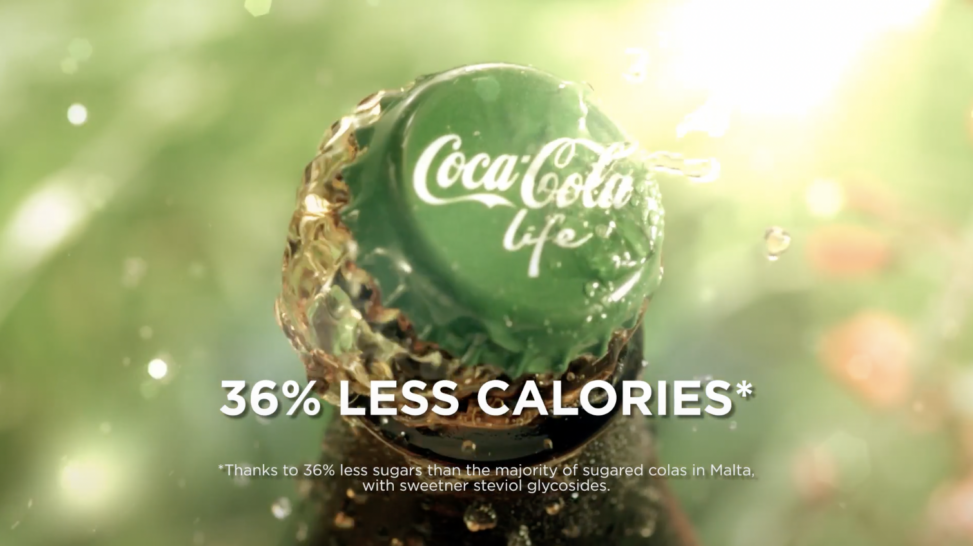Coca-Cola has been a well-known brand for many years, creating famous products that are part of popular culture around the world. One of their products is Coca-Cola Life, which is marketed as a lower-sugar and “eco-friendly” option compared to their regular drinks. Ads for Coca-Cola Life usually highlight ideas like sustainability, nature, and health, using images to share these messages.
In the Coca-Cola Life advertisement, the most noticeable visual element is the green label on the bottle, which represents naturalness and eco-friendliness. The color green is associated with environmental awareness, health, and sustainability. The bottle is shown in a lush, green setting, possibly in a forest or other natural environment, further suggesting a connection between the product and nature.
Coca-Cola claims that this advertisement is a socially responsible choice due to its reduced sugar content and the use of natural sweeteners, such as stevia. This aligns with growing consumer concerns about health, wellness, and the environmental impact of consumption. Additionally, Coca-Cola attempts to present itself as a company that cares about its environmental footprint and is taking steps towards social responsibility.
The company wants consumers to associate their choice of drink with contributing positively to the environment, promoting the idea that buying Coca-Cola Life aligns with ethical and sustainable values. The advertisement seeks to convince the audience to purchase this product by linking it with a broader lifestyle change towards better health and eco-friendliness.
The target audience for this ad is likely young adults and health-conscious consumers who are increasingly concerned with environmental and social responsibility. Studies show that millennials and Gen Z are more inclined to support brands that demonstrate social responsibility and sustainability. According to White, Habib, and Hardisty (2019), these consumer groups prioritize ethical consumption and are willing to pay more for products that align with their values. They care about what they consume and its impact on the environment.
The reduced sugar content of Coca-Cola Life also appeals to people trying to make healthier dietary choices. Awareness of the dangers of high sugar consumption, such as obesity and diabetes, has increased demand for low-sugar or sugar-free drinks. According to Zhen et al. (2011), as consumers become more informed about the health risks of sugar, they are more likely to choose alternatives that promise lower sugar content without sacrificing taste.
The ad is visually appealing and likely effective in capturing the attention of its target audience. The natural setting and the prominent use of green in both the product and the background reinforce the connection between Coca-Cola Life and environmental sustainability. The minimalist design allows the viewer to focus on the product itself without being overwhelmed by excessive information.
The emotional appeal of the ad also plays a crucial role in its effectiveness. By using imagery associated with nature and health, Coca-Cola creates a positive emotional response in viewers who care about the environment and their well-being. According to Ottman et al. (2006), an emotional connection is essential for companies marketing environmentally friendly products, as it creates a sense of personal involvement for the consumer.
However, there is growing skepticism about the authenticity of such eco-friendly claims, often referred to as “greenwashing.” Critics argue that while Coca-Cola Life contains less sugar than regular Coca-Cola, it is not sugar-free and may still contribute to health issues related to sugar consumption. Gatti, Seele, and Rademacher (2019) warn that as consumers become more aware of greenwashing, brands that fail to live up to their promises may lose consumer trust.
Coca-Cola has faced substantial criticism for its environmental practices. While the company promotes its efforts to reduce plastic waste and use more recyclable materials, it remains one of the largest producers of plastic bottles globally. According to a report by Greenpeace (2020), Coca-Cola was found to be the top plastic polluter worldwide, contributing significantly to the global plastic waste crisis. Despite initiatives to recycle and use more sustainable packaging, the sheer volume of plastic waste associated with Coca-Cola products remains a major environmental concern.
Moreover, Coca-Cola has been criticized for its water usage, particularly in drought-prone areas where its over-extraction of water has led to water shortages for local communities. In response to these concerns, Coca-Cola has introduced a water replenishment program to balance its water use. However, Gleick (2020) argues that these efforts are insufficient to offset the environmental damage caused by the company’s operations.
The Coca-Cola Life ad effectively appeals to health-conscious and environmentally aware consumers through its visual imagery and green messaging. By positioning Coca-Cola Life as a healthier, more sustainable alternative, the company aims to attract consumers who value ethical consumption. However, despite the initial appeal, there are valid concerns about the authenticity of Coca-Cola’s eco-friendly claims. The company’s ongoing environmental challenges, particularly related to plastic waste and water use, undermine the sustainability message in its advertisements. As consumers become more critical of corporate greenwashing, Coca-Cola will need to make more meaningful changes to maintain consumer trust in the long term.
**Image is a screen grab from an advertisement on YouTube**
Bibliography:
Gatti, Lucia, Peter Seele, and Lutz Rademacher. “Grey Zone in – Greenwash Out: A Review of Greenwashing Research and Implications for the Voluntary-Mandatory Transition of CSR.” International Journal of Corporate Social Responsibility 4, no. 6 (2019) https://doi.org/10.1186/s40991-019-0044-9.
Gleick, Peter H. The World’s Water Volume 8: The Biennial Report on Freshwater Resources. Washington, DC: Island Press, 2020.
Greenpeace Aotearoa. “Unbottling the Truth: Coca-Cola’s Role in Plastic Pollution.” Accessed October 1, 2024. https://www.greenpeace.org/aotearoa/story/unbottling-the-truth-coca-colas-role-in-plastic-pollution/.
Ottman, Jacquelyn A., Edwin R. Stafford, and Cathy L. Hartman. 2006. “Avoiding Green Marketing Myopia: Ways to Improve Consumer Appeal for Environmentally Preferable Products.” Environment: Science and Policy for Sustainable Development 48 (5): 22–36. doi:10.3200/ENVT.48.5.22-36.
White, Katherine, Rishad Habib, and David J. Hardisty. “How to SHIFT Consumer Behaviors to Be More Sustainable: A Literature Review and Guiding Framework.” Journal of Marketing 83, no. 3 (2019): 22–49.
Zhen, Chen, Eric A. Finkelstein, James M. Nonnemaker, Shawn A. Karns, and Jessica E. Todd. “Predicting the Effects of Sugar-Sweetened Beverage Taxes on Food and Beverage Demand in a Large Demand System.” American Journal of Agricultural Economics 93, no. 2 (2011): 527–51.
MyCoke Malta. “Coca-Cola Life Advert.” YouTube video. https://www.youtube.com/watch?v=qDOw-G3-9a8.


JP Amanse
First things first, this was a very well written analysis. Not only did you highlight the negative effects of Coca-Cola towards the environment, but as well to the human body. You made interesting points about the green color of the bottle and cap itself by stating that the color represents the “naturalness” and “eco-friendliness” of the brand. You also mentioned that the bottle is shown in a lush and green setting that looks like that of a forest and green environment which suggested a link between the product and mother nature itself which I agree with. You stated that Coca-Cola is one of the biggest producers of plastic bottles globally which further proves the brand is not as eco-friendly as people think. I learned that Coca-Cola was the top plastic polluter worldwide which surprised me at first but then I remembered Coca-Cola owns many other soft beverage companies as well which contribute to the brand’s overall pollution. You made a point about Coca-Cola extracting water from drought-prone areas which leads to water shortages in communities. This part really made me think “wow”, imagine if this happened to Kamloops. We would need to find water through other means if Coca-Cola exhausted the city’s water supply. You absolutely hit it out the park with the use of six scholarly sources plus the image link as well. I don’t think you missed anything except re-mentioning the brand’s effects on health in your conclusion. This however is a minor critique from me and doesn’t undermine this well written analysis. Great Job MJ!